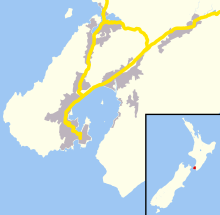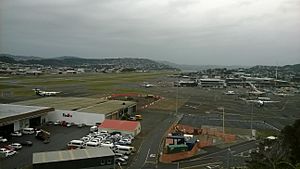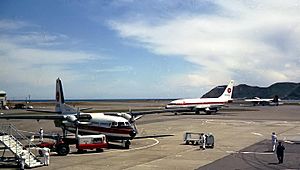Wellington Airport facts for kids
Quick facts for kids
Wellington Airport
|
|||||||||||
|---|---|---|---|---|---|---|---|---|---|---|---|
 |
|||||||||||
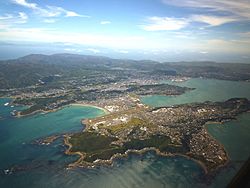 |
|||||||||||
| Summary | |||||||||||
| Airport type | Public | ||||||||||
| Owner |
|
||||||||||
| Operator | Wellington International Airport Ltd | ||||||||||
| Serves | Wellington, New Zealand | ||||||||||
| Location | Rongotai, Wellington, New Zealand | ||||||||||
| Hub for | Air New Zealand | ||||||||||
| Elevation AMSL | 13 m / 42 ft | ||||||||||
| Coordinates | 41°19′38″S 174°48′19″E / 41.32722°S 174.80528°E | ||||||||||
| Map | |||||||||||
| Runway | |||||||||||
|
|||||||||||
| Statistics (Year ending 30 June 2019) | |||||||||||
|
|||||||||||
Wellington Airport (IATA: WLG, ICAO: NZWN) is a busy international airport in Wellington, New Zealand. It's the capital city's main airport. You can find it in the suburb of Rongotai, about 5.5 kilometers south-east of the city center.
This airport is a main base, or hub, for Air New Zealand. It is run by Wellington International Airport Limited. This company is a partnership between Infratil and the Wellington City Council.
Wellington Airport is the third busiest airport in New Zealand. It handles millions of passengers each year. Only Auckland and Christchurch airports are busier. It also connects many places within New Zealand. Plus, it has flights to big cities in eastern Australia.
The airport is built on a small piece of land called the Rongotai isthmus. This is a narrow strip of land between Wellington and the Miramar Peninsula. It has one runway that is 2,081 meters long. The airport can handle many types of planes. This includes turboprops, smaller jets, and even large jet aircraft.
Wellington Airport is known for its sometimes bumpy landings. This is because strong, gusty winds often blow through the Cook Strait. These winds can make flying into the airport a bit challenging.
Contents
Airport History
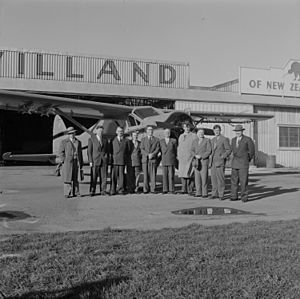
The airport started as Rongotai Airport in November 1929. It had a tar runway. It officially opened in 1935. However, it closed in 1947 because it wasn't safe. Its grass runway often became unusable in winter.
While Rongotai Airport was closed, Paraparaumu Airport was used instead. This airport is about 35 miles north of Wellington. By 1949, Paraparaumu was the busiest airport in New Zealand.
In 1956, there was a plan to move the airport terminal. It would go to the Miramar Golf Course site. Houses were moved and hills were flattened for the new airport. The new Wellington Airport opened on October 25, 1959. It cost about £5 million to build. People wanted an airport closer to the city. Paraparaumu Airport was not good for large planes.
The runway was first 1,630 meters long. It was made longer in the early 1970s. This allowed bigger planes like DC-8s to land. The first domestic terminal was in an old hangar. It was often crowded and leaky.
In 1991, the airport wanted to make its taxiways wider. This plan was stopped after people living nearby protested. The airport bought land from the Miramar Golf Course in 1994 for parking.
Around 1992, other places for Wellington Airport were considered. But it was decided to improve the airport at Rongotai. A big new terminal was finished in 1999. It joined with the international terminal built in 1977. Safety zones were added at both ends of the runway. This was to meet international safety rules.
Since 1998, the airport has been mostly private. Infratil owns two-thirds of it. The Wellington City Council owns the other third.
In 2003, a large statue of Gollum was put in the terminal. This was to promote The Lord of the Rings: The Return of the King movie.
In 2006, Air New Zealand and Qantas wanted to share flights. This would help them fill seats and avoid losing money. But the airport said it would stop competition. The plan was later dropped.
In 2015, Fiji Airways started flights from Nadi to Wellington. Jetstar Airways also began international flights to the Gold Coast. In 2016, Singapore Airlines started direct flights to Wellington. These flights came via Canberra. This was Wellington's first direct flight outside Australia and the Pacific. From 2018, the Singapore Airlines flight changed to go via Melbourne.
Airport Terminal
Layout and Piers
Wellington Airport has one main terminal building. It is located on the east side of the airport. This terminal has three piers: South, South-West, and North-West. The whole terminal area is about 32,300 square meters.
The main terminal has a check-in area on the first floor. The baggage claim area is on the ground floor. Both connect to shops and restaurants on the first floor. These areas look out over the runway.
Gates and Lounges
- South Pier (Gates 3-12) and Main Terminal (Gates 18-20): These gates are for smaller planes. They serve regional flights using propeller aircraft.
- South-West Pier (Gates 13-17): These gates are mostly used by Air New Zealand domestic jets. Most of them have jetbridges. Jetbridges are covered walkways that connect the plane directly to the terminal.
- North-West Pier (Gates 21-29): These gates are used by Jetstar Airways domestic jets. They also handle all international flights. When used for international flights, their numbers change (e.g., Gate 26 becomes Gate 46).
Several airlines have special lounges for their frequent flyers:
- Air New Zealand has three Koru lounges. One is for regional travelers. Another is for domestic jet travelers. The third is for international travelers.
- Qantas and Virgin Australia also have lounges. These are for their members flying internationally.
Airlines and Destinations
| Airlines | Destinations |
|---|---|
| Air Chathams | Chatham Islands |
| Air Kaikoura | Kaikoura |
| Air New Zealand | Auckland, Blenheim, Brisbane, Christchurch, Dunedin, Gisborne, Hamilton, Invercargill, Melbourne, Napier, Nelson, New Plymouth, Queenstown, Palmerston North, Rotorua, Sydney, Tauranga, Timaru Seasonal: Nadi |
| Fiji Airways | Nadi |
| Golden Bay Air | Karamea, Takaka |
| Jetstar Airways | Auckland, Christchurch, Gold Coast, Queenstown |
| Originair | Nelson |
| Qantas | Melbourne, Sydney |
| Sounds Air | Blenheim, Nelson, Picton, Taupo, Westport |
| Virgin Australia | Brisbane, Sydney |
Airport Statistics
| Rank | Airport | Passengers | Annual change |
|---|---|---|---|
| 1 | Sydney | 381,415 | |
| 2 | Melbourne | 267,667 | |
| 3 | Brisbane | 165,616 | |
| 4 | Gold Coast | 53.355 | |
| 5 | Nadi | 30,339 |
Military Air Movements
Air Movements Rongotai is on the other side of the runway from the main passenger terminals. Its main job is to help flights for the RNZAF. It also helps flights for other countries' military forces. The building was updated in the late 1980s. It used to house a unit of the New Zealand Army. This unit managed the movement of defense staff and cargo.
Getting to the Airport
Wellington Airport can only be reached by road. The airport is at the southern end of State Highway 1. This highway connects the airport to Wellington City. You go through the Mount Victoria Tunnel to get there. The distance from the airport to the city center is about 8 kilometers.
Many taxi and shuttle companies serve the airport. There is also one Metlink bus route that stops near the terminal. This is Route 2, which goes between the city center and Miramar/Seatoun. To go to other areas like Porirua or the Kapiti Coast, you need to change to a train at Wellington railway station.
It's hard to connect the airport to the city center by train. This is because the airport is quite far from the railway station. Studies have looked into ways to fix this. One idea is to build a light rail system.
Images for kids
See also
 In Spanish: Aeropuerto Internacional de Wellington para niños
In Spanish: Aeropuerto Internacional de Wellington para niños


